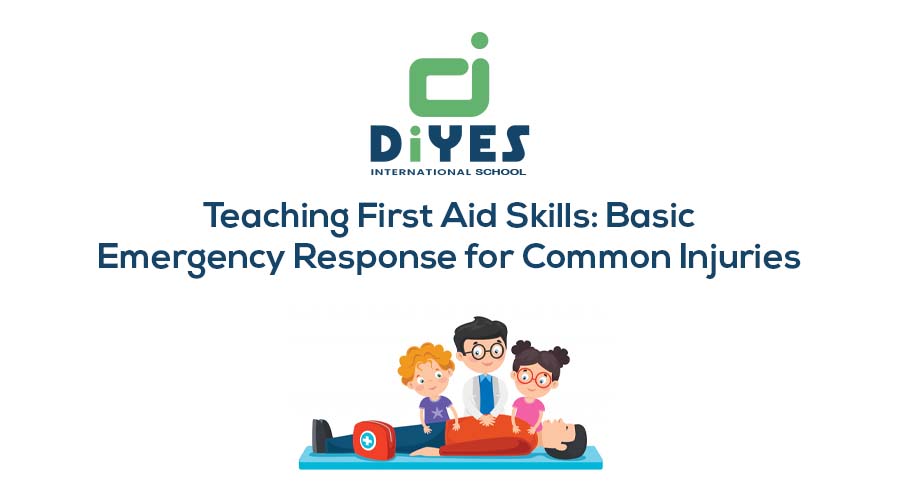Emergencies can strike unexpectedly, and being prepared can significantly impact the outcome. Teaching first aid to kids is a crucial aspect of their education, equipping them with the knowledge and confidence to respond effectively in emergencies. This blog explores practical strategies for teaching first aid to kindergarteners, covering essential skills for managing common injuries and emergencies. By empowering children with these life-saving skills, we can ensure they are prepared to act swiftly and calmly when faced with unexpected situations.

In emergencies, every second counts. Teaching children basic first aid skills are essential for their safety and confidence. This blog provides practical guidelines for parents and educators to equip children with the knowledge and skills to respond to common injuries and emergencies. From handling cuts and scrapes to recognizing signs of more severe issues, discover how to empower children with basic first aid skills that can make a significant difference in critical moments.
Understanding the Importance of First Aid
First aid refers to the immediate assistance provided to an injured or ill individual prior to the arrival of professional medical personnel. Teaching children the importance of first aid helps them understand the value of being prepared and the impact they can have in an emergency.
- Building Confidence: Teaching first aid skills helps build children’s confidence, knowing they can take action in an emergency. This confidence can reduce panic and improve their ability to respond effectively when needed.
- Promoting Safety Awareness: Understanding first aid encourages children to be more aware of their surroundings and potential hazards. This awareness can lead to safer behaviours and a more proactive approach to preventing injuries.
- Empowering Responsibility: Equipping children with first aid knowledge nurture a sense of responsibility towards themselves and others. It teaches them the importance of helping others and being a reliable source of support in critical moments.
- Lifelong Skills: The first aid skills children learn will benefit them throughout their lives, both personally and professionally. These skills can be applied in various situations, from minor injuries at home to more significant emergencies in public settings.
Understanding the importance of first aid empowers children with the confidence, awareness, and responsibility needed to respond effectively in emergencies. These skills are invaluable for their safety and the well-being of those around them.
Teaching Basic First Aid Techniques
Basic first aid techniques are essential skills that every child should learn. These skills can help manage common injuries and provide immediate care until professional help arrives.
- Handling Cuts and Scrapes: Teach children how to clean a wound with water, apply an antiseptic, and cover it with a sterile bandage. Emphasize the importance of keeping the wound clean to prevent infection.
- Treating Burns: Show children how to cool a burn under running water for at least 10 minutes and avoid using ice or butter. Explain the importance of covering the burn with a clean, non-stick dressing and seeking medical help for severe burns.
- Managing Sprains and Strains: Teach children the R.I.C.E. method (Rest, Ice, Compression, Elevation) for managing sprains and strains. Demonstrate how to apply ice packs and elastic bandages properly.
- Responding to Choking: Teach children the signs of choking and how to perform the Heimlich manoeuvre on themselves and others. Practice the technique using a doll or a pillow to ensure they understand the proper procedure.
By teaching children basic first aid techniques, we equip them with the skills needed to manage common injuries and provide immediate care. These skills can make a significant difference in an emergency and help ensure a safer environment for everyone.
Recognizing and Responding to Serious Injuries
Recognizing the signs of serious injuries and knowing how to respond is crucial for providing timely and effective care. Teaching children these skills can help them stay calm and take appropriate action in critical situations.
- Identifying Signs of Shock: Explain the symptoms of shock, such as pale skin, rapid breathing, and confusion. Teach children to lay the person down, elevate their legs, and keep them warm while waiting for medical help.
- Handling Head Injuries: Discuss the importance of monitoring for signs of a concussion, such as dizziness, headache, and vomiting.

Teach children to seek medical attention immediately if these symptoms occur after a head injury.
- Responding to Severe Bleeding: Show children how to apply direct pressure to a bleeding wound using a clean cloth or bandage. Emphasize the importance of keeping pressure until the bleeding stops or professional help arrives.
- Recognizing Allergic Reactions: Educate children on the signs of severe allergic reactions, such as difficulty breathing, swelling, and hives. Teach them how to use an epinephrine auto-injector if they or someone they know has a severe allergy.
By teaching children how to recognize and respond to serious injuries, we empower them to take swift and appropriate action in critical situations. These skills can be lifesaving and provide essential support until professional help arrives.
Creating a Family Emergency Plan
Having a family emergency plan in place ensures that everyone knows what to do in various emergencies. Involving children in the planning process helps them understand the importance of preparedness and their role in ensuring safety.
- Establishing Communication: Create a list of emergency contacts and ensure children know how to reach them. Practice using different communication methods, such as calling, texting, and using social media to ensure they can contact help in various situations.
- Identifying Safe Spots: Designate safe spots in your home and neighbourhood where family members can meet during emergencies. Practice evacuating to these locations and ensure children know the routes and procedures.
- Assembling a First Aid Kit: Involve children in assembling a family first aid kit. Explain the purpose of each item and how to use it, ensuring they understand the importance of having the kit readily available.
- Practicing Emergency Drills: Conduct regular emergency drills, such as fire, earthquake, and severe weather drills. Practice different scenarios and ensure children understand the procedures and can execute them confidently.
Creating a family emergency plan empowers children with the knowledge and confidence needed to respond effectively in various emergencies. Involving them in the planning process nurtures a sense of responsibility and ensures they are prepared for any situation.
Encouraging Continued Learning and Practice
First aid skills, like any other skills, require continuous learning and practice. Encouraging children to stay informed and practice their skills regularly ensures they are prepared to respond effectively in emergencies.
- Enrolling in First Aid Courses: Look for first aid courses designed for children and enrol them in these programs. These courses provide hands-on training and reinforce the skills learned at home.
- Using Educational Resources: Provide children with access to educational resources, such as books, videos, and online courses, to reinforce their first aid knowledge.

Encourage them to explore these resources and stay informed about the latest techniques and best practices.
- Practicing Scenarios: Regularly practice different emergency scenarios with your children. Use role-playing and simulations to help them apply their first aid skills in various situations, ensuring they are confident and capable of responding effectively.
- Promoting a Culture of Safety: Nurture a culture of safety and preparedness in your home. Encourage open discussions about first aid and emergency response, ensuring children feel comfortable asking questions and seeking guidance.
Creating a family emergency plan empowers children with the knowledge and confidence needed to respond effectively in various emergencies. Involving them in the planning process nurtures a sense of responsibility and ensures they are prepared for any situation.
By encouraging continued learning and practice, we ensure that children remain confident and capable first responders. These ongoing efforts reinforce their skills and knowledge, providing them with the tools needed to respond effectively in any emergency.
Conclusion
Teaching first aid skills to children is a crucial aspect of their education and overall development. By grasping the significance of first aid, instructing fundamental techniques, identifying severe injuries, formulating a family emergency plan, and promoting ongoing education, parents and educators can equip children with the knowledge and confidence to handle emergencies effectively. These skills not only enhance their safety but also nurture a sense of responsibility and preparedness that will benefit them throughout their lives.
First aid skills are invaluable, providing children with the ability to act swiftly and calmly in critical situations. By equipping them with these skills, we can ensure they are prepared to handle common injuries and emergencies, reducing the risk of complications and improving outcomes. Moreover, teaching first aid nurtures a sense of empathy and responsibility, encouraging children to help others in need and contribute to a safer and more supportive community.
The benefits of first aid education extend beyond immediate emergency response. Children who are trained in first aid develop a greater awareness of their surroundings and potential hazards, leading to safer behaviours and a proactive approach to injury prevention. This heightened awareness and preparedness can significantly reduce the risk of accidents and injuries, creating a safer environment for everyone.
In conclusion, teaching first aid skills to children is an investment in their safety, confidence, and overall well-being. By providing them with the knowledge and tools to respond effectively in emergencies, we empower them to make a positive difference in their lives and the lives of others.
At DiYES International School, we recognize the importance of equipping our students with essential life skills, including first aid. Our comprehensive curriculum and hands-on training programs are designed to empower students with the knowledge and confidence to respond effectively in emergencies.
To learn more about DiYES International School and our commitment to nurturing safety and preparedness, visit our website at www.diyesinternational.edu.in or contact us at +918547609000.


